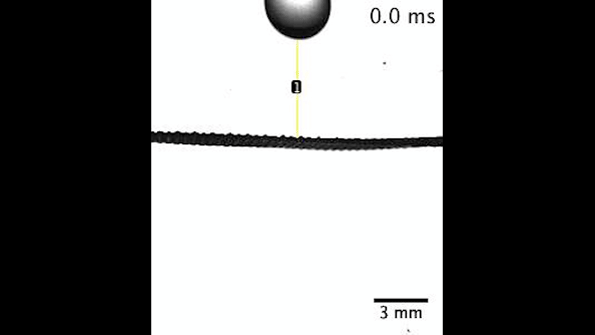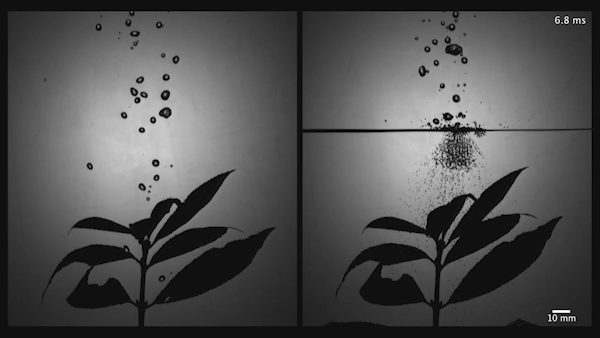Big little droplets
RESEARCHERS at MIT have discovered a method that makes sprayed droplets hit and stick to their targets, that could potentially benefit agriculture and other industries.
Droplet size is important when it comes to spraying paint or coatings onto surfaces, or fertilisers and pesticides onto crops. Large droplets drift less in the wind and are more likely to strike their intended target. Smaller droplets are more likely to stick to their targets. Typically, less than 5% of sprayed liquids actually stick to their intended targets, and 95% or more is wasted. Half is lost to drift and never reaches the target, and the other half bounces away.

The team at MIT discovered a way to balance the properties of size and provide small droplets that don’t drift too far. They placed a fine mesh barrier between the spray and the target, which caused droplets to break up to one-thousandth of their initial size. The large form enabling accuracy, and the smaller, atomised form enabling adherence.
Therefore, sprays in the form of large drops which are less likely to be put off course by wind could be directed at the targets, and the chances of sticking would be increased by subsequent atomisation and conical spray caused by the mesh.
In agriculture, using a mesh to break up droplets would enable farmers to use conventional fertilisers and pesticides that spray out large droplets, but achieve more efficient coverage via atomisation and conical spray as a result of the mesh.
The researchers primarily focused on commonly-available and inexpensive fine stainless-steel mesh, though many kinds of mesh materials would work. What matters is the size of the openings in the mesh, and its thickness. Researchers quantified these through a series of laboratory experiments and mathematical analysis.
Existing methods of atomisation rely on high pressure to force liquid through a narrow opening, but this method saves energy as no pressure is required. The method acts through passive and mechanical means.
Agricultural benefits
In addition to increased efficiency, there are other benefits this method could offer agriculture. Use of the mesh would also reduce loss of expensive chemicals and would decrease the amount of run-off pesticides that miss their targets and fall to the ground, significantly impacting pollution. Reduced bouncing of droplets from plants could also help to prevent pathogens from spreading.
The mesh could also reduce drift, which sometimes causes pesticides to travel from one farmer’s field to another’s, even state to state. Pesticides are also capable of ending up in homes. Krispa Varanasi, associate professor of mechanical engineering and co-author of the study, said this is something people want fixed, and for which a solution is being sought.

A further benefit of using meshes like this in agriculture is the protection from impact they could offer crops, especially in rainstorms. During storms rain droplets can strike plants with enough force to place stress upon the plant leading to crop damage, resulting in reduced yields.
For agriculture these meshes could be deployed and supported by plant stalks or supported on framework, and then farmers would be able to use conventional sprayers that produce larger droplets which stay on course even in breezy conditions.
Farmers already use fabric meshes to protect certain types of crop from birds and insects, so the process is already familiar and widely used.
Other potential applications
The principle also has potential to be used in a variety of applications, such as cooling towers and multi-effect desalination.
In the example of cooling towers, such as those used for electric power plants, and many industrial or chemical plants, mesh could be placed below spray heads to create finer droplets. Cooling efficiency is related to droplet surface area, and so finer droplets would evaporate faster and provide better cooling. Henri-Lois Girard, a graduate student, said that cooling efficiency is three orders of magnitude greater with the finer drops.
In recent work, Varanasi and his team found a way to recover a large amount of the water lost from cooling towers by evaporation, by using a different kind of mesh over the top of cooling towers. The new findings combined with the old therefore have the potential to improve power plant efficiency at input and output stages.
Girard also mentioned the benefits of using this method during the application of coatings. For applying paint, and other types of coating, finer droplets are better at covering and adhering to surfaces. Mesh could be employed to improve the quality and durability of coatings.
Physical Review Fluids: http://doi.org/ctm7
Recent Editions
Catch up on the latest news, views and jobs from The Chemical Engineer. Below are the four latest issues. View a wider selection of the archive from within the Magazine section of this site.




